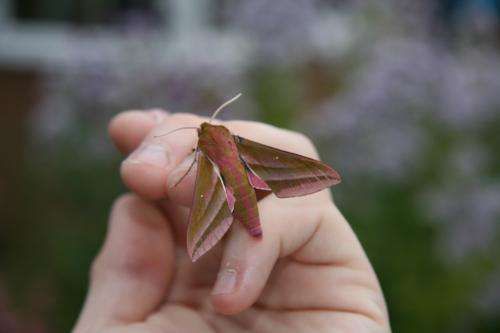Like a moth to a street light

A new research project will investigate how street lighting impacts on the many hundreds of species of moths that can be found in Britain.
Whilst moths may not be everyone's favourite insect, it is widely recognised that they play a vital role in the ecosystem as food for a variety of other wildlife, including birds and bats. However, scientists at the University of Hull believe that moths are in danger of being overlooked as important contributors to the pollination of plants. They are also concerned that light pollution, particularly that caused by street lights, may have a negative impact on moth populations.
The research is being carried out by PhD student Callum Macgregor, who joined the University in 2013 after completing an undergraduate degree in biology at the University of Oxford. The project will look at both how moths contribute to plant pollination and whether they are adversely affected by street lighting.
Callum said: "We already know that moths are important pollinators of some plant species, for example, the small flowers of the White Campion have a scent that has evolved specifically to attract moths during the night.
"What we don't fully understand is the relative importance of moths as pollinators and whether moths are playing a role in the pollination of food crops."
The project is part of the University of Hull's Energy and Environment research theme, and is carried out jointly with the Centre for Ecology and Hydrology, and Butterfly Conservation (BC). The project is funded by the Natural Environment Research Council (NERC) with support from BC.
Dr Darren Evans, who leads the Biological Conservation Group at the University of Hull and is overseeing the project, explained why the impact of street lighting on moths will also be investigated: "In the last 35 years, around two thirds of our larger moth species have declined in the UK," he said. "If we are correct and moths do indeed play an important role in pollination, then this decline is likely to have a knock-on effect in terms of crop production.
"Light pollution, habitat modification and pesticide use are all likely to have contributed to this reduction in moth biodiversity, so we are not saying that street lights are solely to blame. It's possible however that some street lighting technologies are more of a problem for moths than others and if so, we think it's important to know what these are."
Street lights traditionally use metal halide or high-pressure sodium lamps to illuminate the streets below, however new technologies including LED lights are now appearing across the UK.
"About a third of the UK's street lights are due to be replaced with new lighting technology," said Dr Evans. "We hope this project will provide policy-makers, conservationists and land managers with much needed evidence on what effect these different technologies have on our native moth population."
For Callum, this PhD project is an opportunity to increase understanding about a group of insects that has fascinated him since he was a teenager:
"At 16, whilst volunteering with the RSPB, I opened up my first ever moth trap to find a huge Poplar Hawk-moth. It was that encounter which first sparked my interest and I am delighted to be part of a project that may help protect these remarkable species."
Provided by University of Hull



















